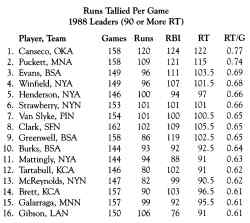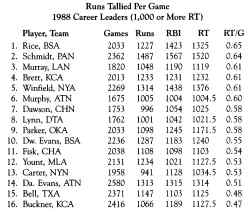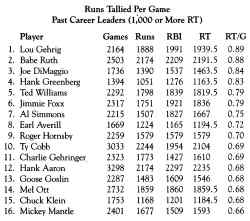|
BARRY CODELL © 1989, Barry Codell The homer hitter is the only player who scores or drives in a run without the assistance of a teammate. This new statistic gives the circuit clout full recognition. RUNS TALLIED ("RT") is a simple measure of offensive production ("tally" was Henry Chadwick's term in the first box score). The team with the most runs tallied invariably wins the game; the player who tallies most for his team has been most valuable toward this victory. Runs Tallied reinstates the primacy of the home run - the only scoring a player accomplishes without the aid of a teammate. It is based on the premise that all other runs are collaborative efforts. Virtually all team runs, aside from home runs, are a combination of a run scored and a run batted in (except for defensive lapses ["DL's"] or double play grounders ["GIDP's"], which score those runs not batted in). The batters or baserunners contributing to these runs are equally important; no run can exist without both of them. So a "non-homer" team run is generally ½ R and ½ RBI (occasionally ½ R and ½ DL), while a home run is one full run tallied. The ultimate offensive payoff for team and individual is in Runs Tallied, as is shown by the following formula: [(R - HR) ± 2] + [(RBI - HR) ÷ 2] + HR = RT. This formula separates the contributory tallies (runs and RBI) from the solo tally (home runs). This formula can be further reduced to
 Note that this simplified formula gives a credit of one RT for a home run, since a home run produces both a R and a RBI for the player. In other words, the simple averaging of runs and RBI results in Runs Tallied (RT). No computer - not even a calculator - is needed here.
Note that this simplified formula gives a credit of one RT for a home run, since a home run produces both a R and a RBI for the player. In other words, the simple averaging of runs and RBI results in Runs Tallied (RT). No computer - not even a calculator - is needed here. The essence of RT is that home runs are already given their true doubled value when runs and runs batted in are added. The well-known "strength" of Runs Produced (subtracting homers or R + RBI - HR = RP) is actually its fatal weakness. Let's go to two examples to see this: the 1988 statistics of Kirby Puckett and Jose Canseco, and the all-time bests of Lou Gehrig and Babe Ruth.
| G | R | RBI | HR | RP | RT | | Puckett | 158 | 109 | 121 | 24 | 206 | 115 | | Canseco | 158 | 120 | 124 | 42 | 202 | 122 | Canseco's 1988 supremacy is reaffirmed by the RT. His singular 40/40 season added up to 0.77 Runs Tallied per Game - the best in the majors. Interesting applications of the RT could include RT/Team, RT/Game, RT/Plate Appearance, but what is undeniable is this: However gaudy the hitting or baserunning, if a player does not tally runs, it's all window dressing. For the score, after all, is the essential stat. Gehrig's famous 301 Runs Produced (1931) get knocked down a peg by Babe Ruth (who else?) and his all-time single-season (1921) RT:
| G | R | RBI | HR | RP | RT | | Gehrig | 155 | 163 | 184 | 46 | 301 | 173.5 | | Ruth | 152 | 177 | 171 | 59 | 289 | 174 | Ruth's 1.14 Runs Tallied per Game is also an all-time best, but Gehrig's 0.89 RT/G reigns supreme career-wise. New Hall of Famers Johnny Bench (0.56 RT/G) and Carl Yastrzemski (0.55 RT/G) and all-time hit leader, Pete Rose (0.49 RT/G!) are surprisingly low in this latter category. The comparisons, as with all statistics, are endless (see accompanying charts). Perhaps they will be done by a new generation of statisticians, without PC's, armed only with baseball cards and minds, following this simple commandment: Average those runs and RBI! It's all right there – in RT. Barry Codell is a nursing home director in Chicago, winner of the Governor's Award for Innovation in Gerontology, and the inventor of the base-out percentage ("BRJ," 1979).



|





